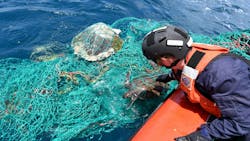The lighting industry is accustomed to reports of LED illumination upsetting wildlife. So it was refreshing to see a new study in which the opposite appears to be true: Flashing LEDs on fishing nets in Cyprus might have drastically reduced the number of accidentally snagged sea turtles.
First, a disclaimer: The scientists behind the findings in the April edition of Science Direct cautioned that the lights were only one contributing factor, and that “more trials with greater capacity are advised.”
Nevertheless, the results were encouraging for anyone concerned with the welfare of sea turtles.
Scientists from the U.K.’s University of Exeter examined the benefits of attaching flashing green LED lights to fishing nets used by a small-scale fishing fleet in Cyprus. Specifically, the team observed whether the lights reduced the “bycatch” of sea turtles, skates, and rays, with a particular focus on sea turtles.
Bycatch — fishing industry terminology for the accidental catch of a species while fishing for a different species — is a big problem. The set nets typically used by the Mediterranean’s many small- scale fisheries sit at the bottom of the sea, inducing foraging by sea turtles and leading to “high rates of mortality,” noted the authors led by Robin T.E. Snape of Exeter’s Penryn, England campus in Cornwall.
Small-scale fisheries comprise over 80% of Mediterranean fleets, the authors pointed out. While they can be known for fishing practices that are more sustainable than those practiced by larger industrialized fleets, the authors claimed that bycatch can actually be greater in small-scale operations.
“Bycatch in set nets contribute to continued population declines,” the study noted. “There are also costs to fishers of hauling and handling these non-target species.”
In Cyprus alone, around 2,800 sea turtles die annually as a result of bycatch, according to the report.
The team of scientists worked with a fishery in Famagusta Bay in northeastern Cyprus (the Turkish administered section of the island), outfitting nets with battery-powered flashing green LEDs from Dartington, England–based Fishtek Marine. Fishtek makes a number of light, acoustic, and electrically pulsed products aimed at deterring bycatch. Its lineup includes an offering called NetLight, which it customized for the Cypriot trial.
“NetLights reduced sea turtle and batoid bycatch by 42% and 50%, respectively,” the Exeter team reported. (Batoids are skates and rays and other flat fish with cartilage for skeletons and pectoral fins fused to the head.) At the same time, the lights did not impede the commercially targeted fish, which were pandora bream and rabbitfish. It also did not deter invasive species such as pufferfish and lionfish.
“The study supports other findings globally that net illumination can reduce bycatch of threatened marine vertebrates,” the authors wrote. They noted that general uptake would require development of affordable and easy-to-attach lights.
The authors also noted that other factors, such as sea depth, are greater factors in bycatch than lighting alone.
Artificial lighting in the developed world has long been implicated for its detrimental effects on wildlife in air, land, and sea. But the Cypriot trial is not the first time that LEDs have been shown to come to the rescue.
For example, in another case involving sea turtles, amber tuned lights have helped ensure that hatchlings make it to water. And several years ago, a Dutch team found that lights tuned to the red spectrum would not deter bats from their typical behaviors.
MARK HALPER is a contributing editor for LEDs Magazine, and an energy, technology, and business journalist ([email protected]).
Follow our LinkedIn page for our latest news updates, contributed articles, and commentary, and our Facebook page for events announcements and more. You can also find us on the X platform.

Mark Halper | Contributing Editor, LEDs Magazine, and Business/Energy/Technology Journalist
Mark Halper is a freelance business, technology, and science journalist who covers everything from media moguls to subatomic particles. Halper has written from locations around the world for TIME Magazine, Fortune, Forbes, the New York Times, the Financial Times, the Guardian, CBS, Wired, and many others. A US citizen living in Britain, he cut his journalism teeth cutting and pasting copy for an English-language daily newspaper in Mexico City. Halper has a BA in history from Cornell University.



![The DesignLights Consortium continues to make progress in shifting outdoor lighting products and implementation practices toward a more restrained and thoughtful strategy. [Image does not represent a DLC qualified fixture.] The DesignLights Consortium continues to make progress in shifting outdoor lighting products and implementation practices toward a more restrained and thoughtful strategy. [Image does not represent a DLC qualified fixture.]](https://img.ledsmagazine.com/files/base/ebm/leds/image/2024/08/66be810888ae93f656446f61-dreamstime_m_265700653.png?auto=format,compress&fit=&q=45&h=139&height=139&w=250&width=250)

